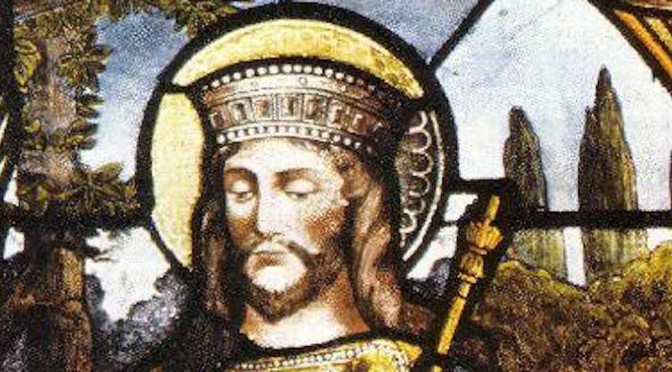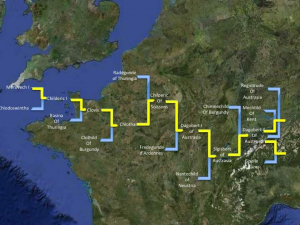 The opportunity to share the bloodline came through an accident of fate. In the Frankish empire civil war was endemic. In 679 A.D Dagobert II, a descendant of Clovis,had been in exile in Britain. He was invited to return to the throne but brought back a British Princess as his bride and set about promoting the Celtic version of Christianity in his Frankish kingdom.
The opportunity to share the bloodline came through an accident of fate. In the Frankish empire civil war was endemic. In 679 A.D Dagobert II, a descendant of Clovis,had been in exile in Britain. He was invited to return to the throne but brought back a British Princess as his bride and set about promoting the Celtic version of Christianity in his Frankish kingdom.
During a hunt, Dagobert was attacked and disappeared, presumed murdered. The proponents of the Dagobert line proposed that he escaped to the northern slopes of the Pyrenees where he married again and created a new family. He married the heiress to the Comte de Razes. Dagobert’s new family made available the bloodline of Clovis, the Messanic bloodline, to families outside of the Merovingian royal family .
Eventually, Dagobert’s nephew, Childeric III, was deposed in 751 by Pepin III, who founded Carolingian dynasty, kings of the second race, but not before the Carolingians had married daughters of the later Merovingian Kings and therefore inherited the much prized bloodline themselves.
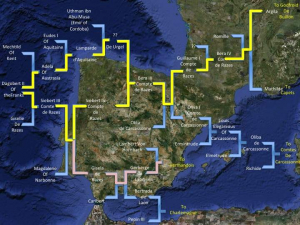
Thus Sigisbert, Dagobert’s son found himself as the Comte de Razes, but brought up to believe that he was the rightful king of Austrasia and possibly rightful king of all the Franks. The Razes is a small area southwest of Carcassonne.
The important issue is that the people in the 14th century(and perhaps today) believed in this story of the survival of Dagobert’s descendants and felt that the deposed counts of Razes had a greater claim to the seniority of the Merovingian bloodline than the Carolingian kings of the Franks. For the families who could in this way claim to be decendants from Dagobert, it seemed that they had bypassed the claims of the Carolingians to rule by divine right and acquired a right to rule themselves.
The Popes obviously assumed that the descendants of this marriage were both relevant to considerations of holy blood and threatening. They initially pursued a campaign dedicated to obscuring the memory of Dagobert, because the existing agreement with the Frankish kings was threatened. Initially the proponents of the Dagobert line cared nothing for Giselles’s heritage
The Salic Franks were a patriarchal society, the Messianic bloodline was a patriarchal line. Female succession was discounted. Those whose primary aim was to claim a Frankish throne or perhaps even the title of “King of all Franks’ adhered to that salic tradition.
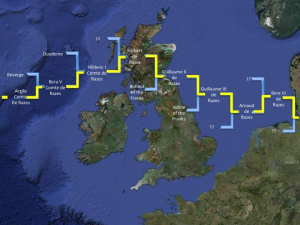 We know about the Comtes de Razes from the Razes family themselves. In 850 Sigbert V of Razes, also known as “Prince Ursus” was at the very least involved in or more probably lead a revolt against the Aquitane branch of the Carolingian ruler, Charles III (the Bald}. The revolt failed and Sigbert fled to Brittany, which as a result of the revolt gained a measure of autonomy from the Franks.
We know about the Comtes de Razes from the Razes family themselves. In 850 Sigbert V of Razes, also known as “Prince Ursus” was at the very least involved in or more probably lead a revolt against the Aquitane branch of the Carolingian ruler, Charles III (the Bald}. The revolt failed and Sigbert fled to Brittany, which as a result of the revolt gained a measure of autonomy from the Franks.
It was during this campagne that Sigibert V raised the issue of his parentage. In the salic tradition a direct male descent from Dagobert meant Sigisbert was a member of a more senior Merovingian line than his opponent Charles, or even of his ally Pepin II of Aquitaine. From Brittany Sigibert published his case , which was strong enough for it to destabilise the Carolingian monarchy and led to the introduction of the “kings of the third race”, the Robertians.
As a historical figure Sigisbert V was unimportant but the claims he made about his parentage were not forgotten. He had made the key point that the female descent to the main line of the Carolingians might not be the most senior line!
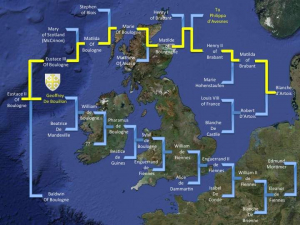 The family then moved between England and Normandy and after a second creation of their title in the south changed their name to Joinville. They became administrators to many aristocratic families and became known as historians and geneologists.
The family then moved between England and Normandy and after a second creation of their title in the south changed their name to Joinville. They became administrators to many aristocratic families and became known as historians and geneologists.
They used their opportunities to indulge in shameless self-promotion which emphasized their descent from Dagobert and therefore by implication the Messanic bloodline. The children of the Joinville family became sought after as a means by which the bloodline could be introduced to many aristocratic and royal families.
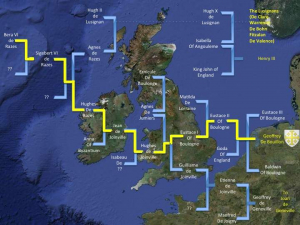 A measure of the success of their promotional activity is that Godfroid de Bouillon a relatively minor aristocrat was chosen by the Pope to lead the first crusade to the Holy Land only because he was part of the Joinville family. Godfroid’s brother Baldwin was crowned king of Jerusalem. This choice was considered so significant in the medieval world that it was the bloodline from Dagobert to Godfroid was christened the Dagobert line.
A measure of the success of their promotional activity is that Godfroid de Bouillon a relatively minor aristocrat was chosen by the Pope to lead the first crusade to the Holy Land only because he was part of the Joinville family. Godfroid’s brother Baldwin was crowned king of Jerusalem. This choice was considered so significant in the medieval world that it was the bloodline from Dagobert to Godfroid was christened the Dagobert line.
The Dagobert line continued. There were however very few lines where the patriarchal requirement was met.
